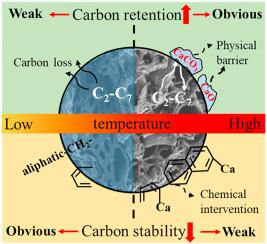当前位置:
X-MOL 学术
›
Environ. Pollut.
›
论文详情
Our official English website, www.x-mol.net, welcomes your
feedback! (Note: you will need to create a separate account there.)
Pyrolysis temperature-dependent carbon retention and stability of biochar with participation of calcium: Implications to carbon sequestration
Environmental Pollution ( IF 7.6 ) Pub Date : 2021-06-09 , DOI: 10.1016/j.envpol.2021.117566 Hongyan Nan 1 , Jianxiang Yin 2 , Fan Yang 3 , Ying Luo 1 , Ling Zhao 1 , Xinde Cao 4
Environmental Pollution ( IF 7.6 ) Pub Date : 2021-06-09 , DOI: 10.1016/j.envpol.2021.117566 Hongyan Nan 1 , Jianxiang Yin 2 , Fan Yang 3 , Ying Luo 1 , Ling Zhao 1 , Xinde Cao 4
Affiliation

|
Converting biomass waste into biochar by slow pyrolysis with subsequent soil amendment is a prospective approach with multiple environmental benefits including soil contamination remediation, soil amelioration and carbon sequestration. This study selected cow manure as precursor to produce biochar under 300 °C, 400 °C, 500 °C and 600 °C, and a remarkable promotion of carbon (C) retention in biochar by incorporation of exogenous Ca was achieved at all investigated pyrolysis temperatures. The C retention was elevated from 49.2 to 68.3% of pristine biochars to 66.1–79.7% of Ca-composite biochars. It was interesting that extent of this improvement increased gradually with rising of pyrolysis temperature, i.e., doping Ca in biomass promoted pyrolytic C retention in biochar by 16.6%, 23.4%, 29.1% and 31.1% for 300 °C, 400 °C, 500 °C and 600 °C, respectively. Thermogravimetric-mass spectrometer (TG-MS) and X-ray photoelectron spectroscopy (XPS) showed that Ca catalyzed thermal-chemical reactions and simultaneously suppressed the release of small organic molecular substances (C–C) via physical blocking (CaO, CaCO, and CaClOH) and chemical bonding (CO and OC–O). The catalyzation mainly occurred at 200–400 °C, while the suppression was more prominent at higher temperatures. Raman spectra and 2D FTIR analysis on biochar microstructure showed that presence of Ca had negative influence on carbon aromatization and thus weakened biochar's stability, while increasing pyrolysis temperature enhanced the stability of carbon structure. Finally, with integrating “C retention” during pyrolysis and “C stability” in biochar, the maximum C sequestration (56.3%) was achieved at 600 °C with the participation of Ca. The study highlights the importance of both Ca and pyrolysis temperature in enhancing biochar's capacity of sequestrating C.
中文翻译:

钙参与下的生物炭热解温度依赖性碳保留和稳定性:对碳封存的影响
通过缓慢热解和随后的土壤改良将生物质废物转化为生物炭是一种具有多种环境效益的前瞻性方法,包括土壤污染修复、土壤改良和碳封存。本研究选择牛粪作为前驱体,在 300 °C、400 °C、500 °C 和 600 °C 下生产生物炭,在所有研究的热解过程中,通过掺入外源 Ca,都显着促进了生物炭中碳 (C) 的保留温度。 C保留率从原始生物炭的49.2%至68.3%提高到Ca复合生物炭的66.1%至79.7%。有趣的是,随着热解温度的升高,这种改善的程度逐渐增加,即,在生物质中掺杂Ca,在300℃、400℃、500℃下,使生物炭中的热解C保留率分别提高了16.6%、23.4%、29.1%和31.1%。分别为 ℃ 和 600 ℃。热重质谱仪(TG-MS)和X射线光电子能谱(XPS)表明Ca催化热化学反应,同时通过物理阻断(CaO、CaCO和CaClOH)和化学键(CO 和 OC-O)。催化作用主要发生在200~400℃,而抑制作用在较高温度下更为明显。生物炭微观结构的拉曼光谱和二维红外光谱分析表明,Ca的存在对碳芳构化产生负面影响,从而削弱了生物炭的稳定性,而提高热解温度则增强了碳结构的稳定性。最后,结合热解过程中的“C保留”和生物炭中的“C稳定性”,在Ca的参与下,在600℃下实现了最大C封存(56.3%)。该研究强调了 Ca 和热解温度在增强生物炭固碳能力方面的重要性。
更新日期:2021-06-09
中文翻译:

钙参与下的生物炭热解温度依赖性碳保留和稳定性:对碳封存的影响
通过缓慢热解和随后的土壤改良将生物质废物转化为生物炭是一种具有多种环境效益的前瞻性方法,包括土壤污染修复、土壤改良和碳封存。本研究选择牛粪作为前驱体,在 300 °C、400 °C、500 °C 和 600 °C 下生产生物炭,在所有研究的热解过程中,通过掺入外源 Ca,都显着促进了生物炭中碳 (C) 的保留温度。 C保留率从原始生物炭的49.2%至68.3%提高到Ca复合生物炭的66.1%至79.7%。有趣的是,随着热解温度的升高,这种改善的程度逐渐增加,即,在生物质中掺杂Ca,在300℃、400℃、500℃下,使生物炭中的热解C保留率分别提高了16.6%、23.4%、29.1%和31.1%。分别为 ℃ 和 600 ℃。热重质谱仪(TG-MS)和X射线光电子能谱(XPS)表明Ca催化热化学反应,同时通过物理阻断(CaO、CaCO和CaClOH)和化学键(CO 和 OC-O)。催化作用主要发生在200~400℃,而抑制作用在较高温度下更为明显。生物炭微观结构的拉曼光谱和二维红外光谱分析表明,Ca的存在对碳芳构化产生负面影响,从而削弱了生物炭的稳定性,而提高热解温度则增强了碳结构的稳定性。最后,结合热解过程中的“C保留”和生物炭中的“C稳定性”,在Ca的参与下,在600℃下实现了最大C封存(56.3%)。该研究强调了 Ca 和热解温度在增强生物炭固碳能力方面的重要性。











































 京公网安备 11010802027423号
京公网安备 11010802027423号